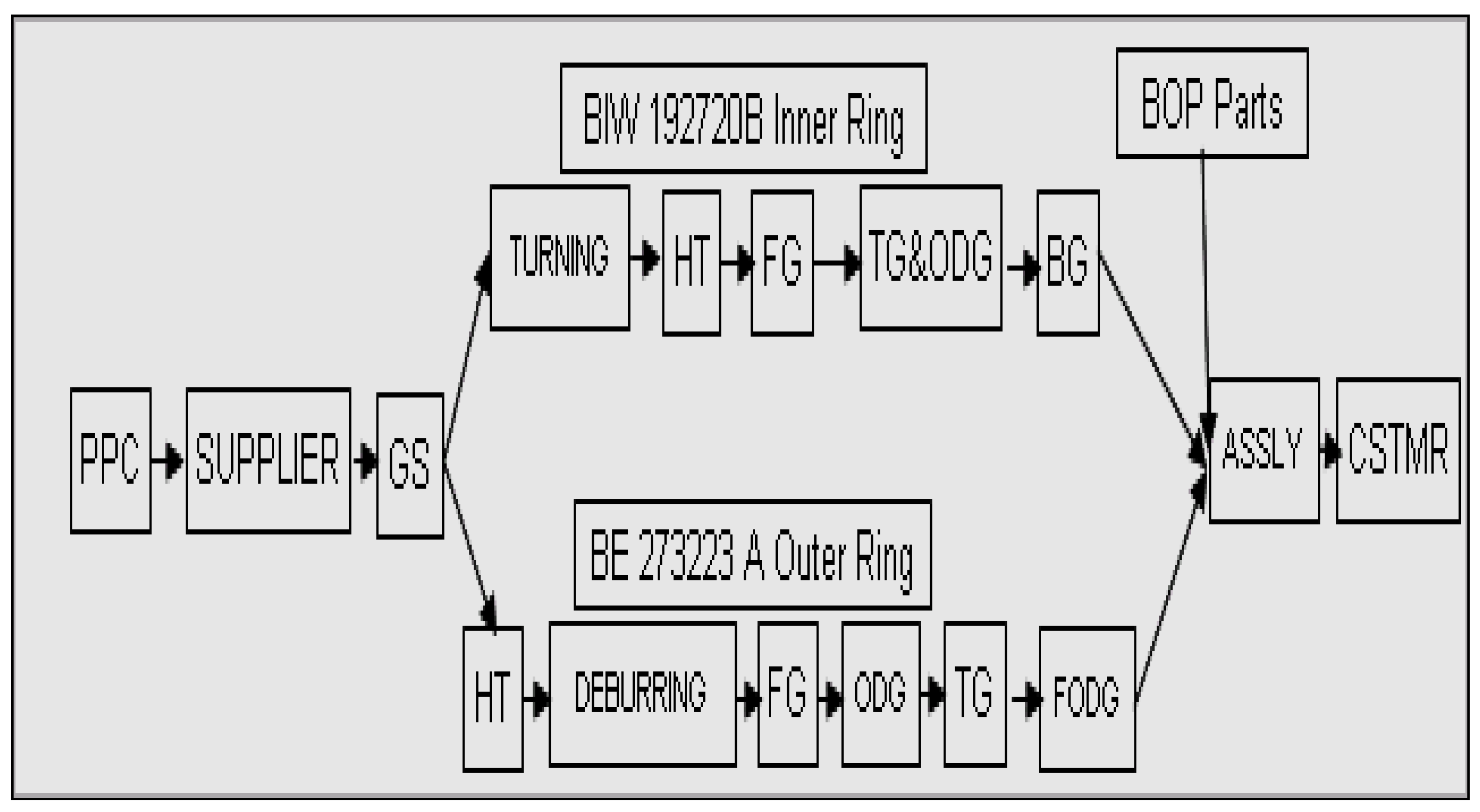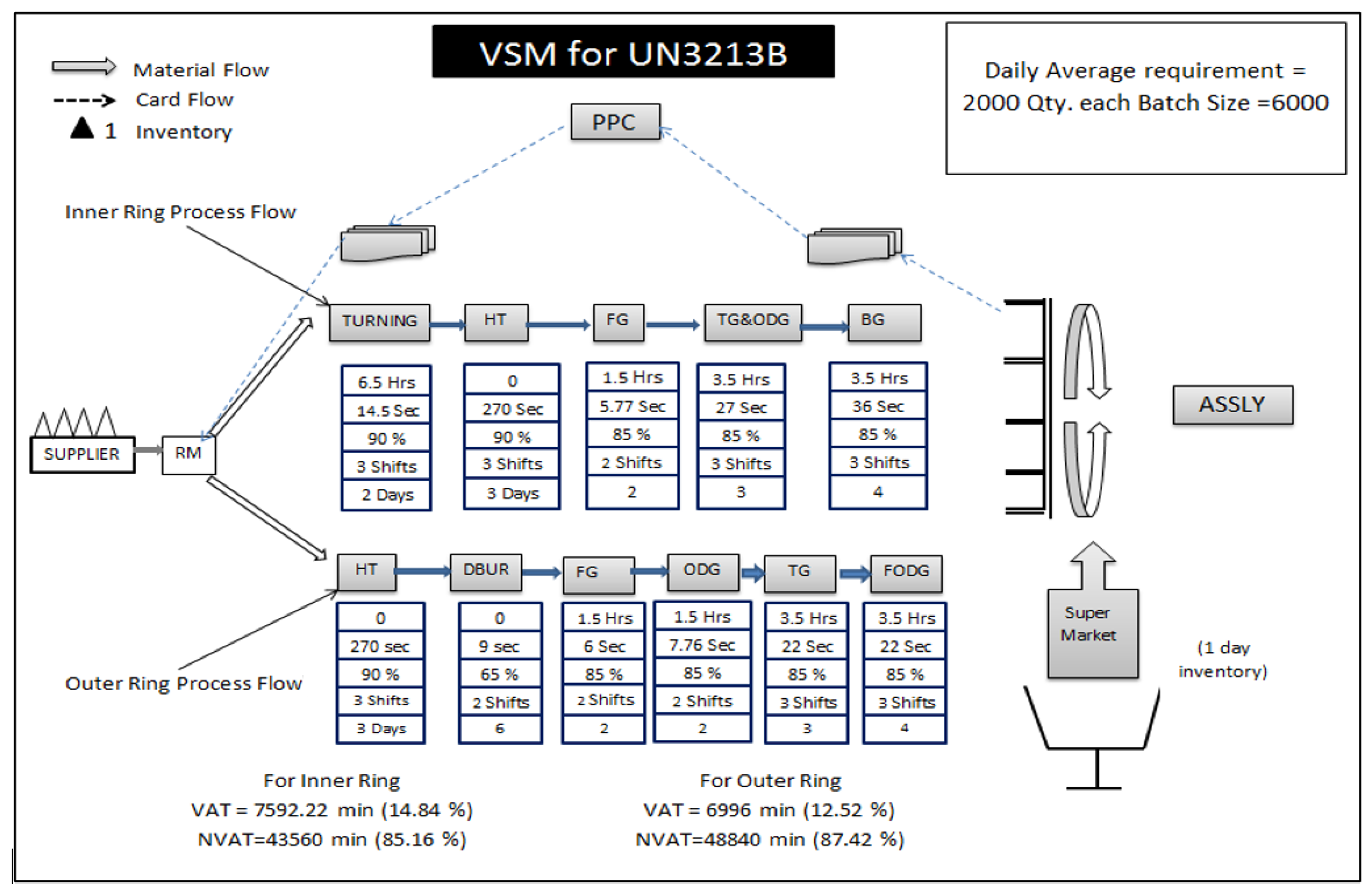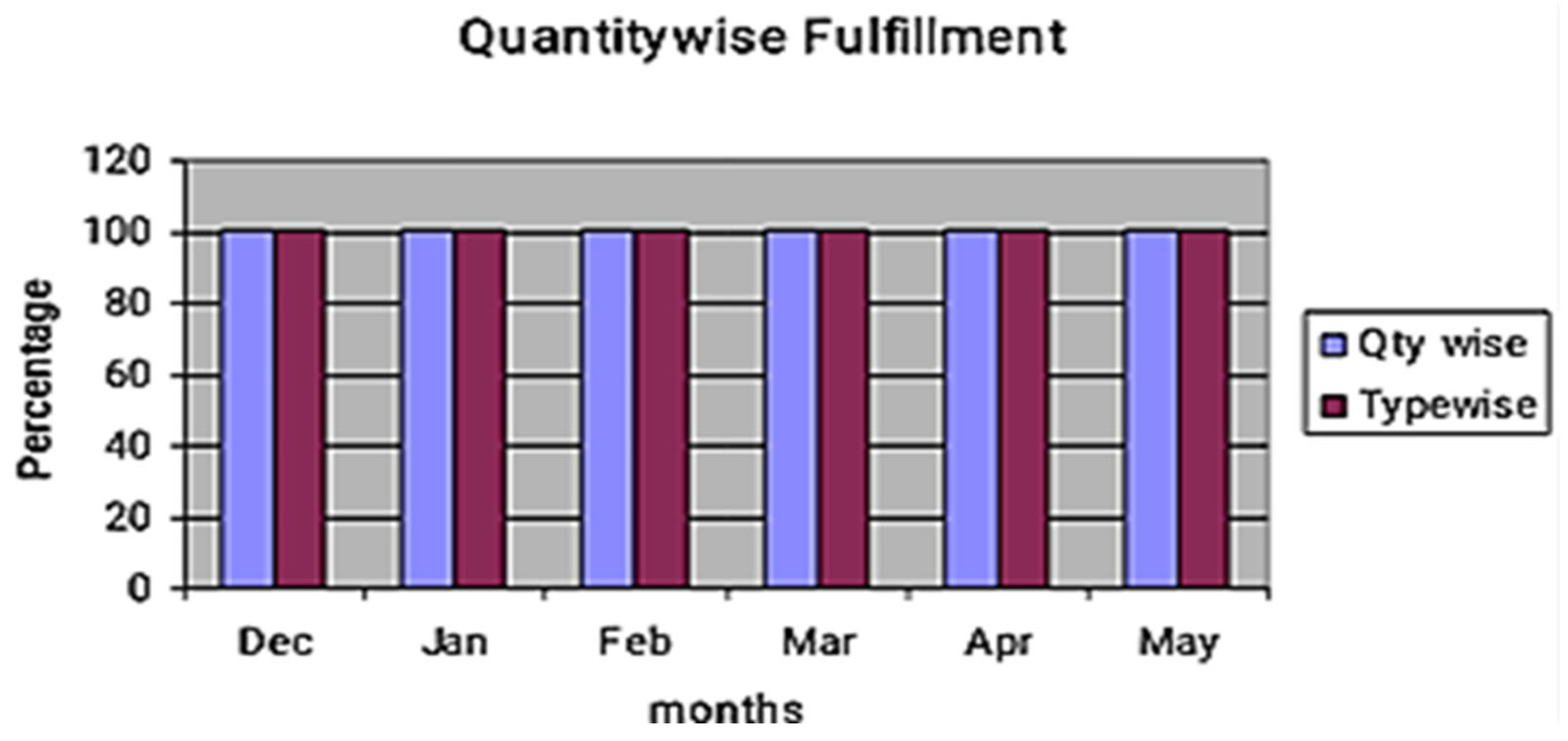Execution of Pull System and Constant Work-in-Process Using Kanban System—A Case Study †
Abstract
1. Introduction
2. Literature Review
3. Problem Definition
4. Methodology
4.1. Kanban and Supermarket-Pull System by Kanban
4.2. KanbanDesign
- D = average daily demand for the product (units/day);
- RT = replenishment time, i.e., the total lead time to produce and restock the item (in days);
- α = safety factor, accounting for uncertainties like machine breakdowns or demand fluctuations (typically 10–50%);
- Q = lot size or container size, i.e., the number of units a single kanban card authorizes.
- D = 1167 units/day (based on monthly demand of ~35,000 units);
- RT for the inner ring = 6.94 to 6.53 days (after improvement);
- Q = 2000 units/card (standard container size);
- α initially = 2.5, later optimized to 2.0 after process stabilization.
4.3. Select Process/Part
4.4. Analyze and Design the Kanban Size
5. Results and Discussion
Industry 4.0 for Organization
6. Conclusions
Author Contributions
Funding
Institutional Review Board Statement
Informed Consent Statement
Data Availability Statement
Acknowledgments
Conflicts of Interest
Nomenclature
| CONWIP | Constant work-in-process |
| WIP | Work-in-process |
| JIT | Just-in-time |
| VSM | Value stream mapping |
| PQ | Product quality |
| N | Number of stages |
| MRP | Materials Requirements Planning |
| UN 3213B | Bottom roller bearing number |
| ASSLY | Assembly |
| CSTMR | Customer |
| BOP | Balance of payment |
| RM | Raw material |
| RT | Replenish time |
| Greek Symbol | |
| A | Safety factor |
References
- Mousli, M. Toyota: Foncer dans le mur et le savoir. Altern. Écon. 2010, 11, 157–167. [Google Scholar] [CrossRef]
- Mojarro-Magaña, M.; Olguín-Tiznado, J.E.; García-Alcaraz, J.L.; Camargo-Wilson, C.; López-Barreras, J.A.; Pérez-López, R.J. Impact of the Planning from the Kanban System on the Company’s Operating Benefits. Sustainability 2018, 10, 2506. [Google Scholar] [CrossRef]
- Yusoff, N.; Halim, H.; Jaffar, A. Implementation of Just in Time Production through Kanban System Implementation of Just in Time Production through Kanban System. Ind. Eng. Lett. 2019, 3, 11–20. [Google Scholar]
- Al-Tahat, M.D.; Mukattash, A.M. Design and analysis of production control scheme for Kanban-based JIT environment. J. Frankl. Inst. 2006, 343, 521–531. [Google Scholar] [CrossRef]
- Deleersnyder, J.-L.; Hodgson, T.J.; Muller-Malek, H.; O’GRady, P.J. Kanban Controlled Pull Systems: An Analytic Approach. Manag. Sci. 1989, 35, 1079–1091. [Google Scholar] [CrossRef]
- Naufal, A.; Jaffar, A.; Yusoff, N.; Hayati, N. Development of Kanban System at Local Manufacturing Company in Malaysia–Case Study. Procedia Eng. 2012, 41, 1721–1726. [Google Scholar] [CrossRef]
- Baker, K.R.; Powell, S.G.; Pyke, D.F. Technical note The performance of push and pull systems: A corrected analysis. Int. J. Prod. Res. 1990, 28, 1731–1736. [Google Scholar] [CrossRef]
- Brown, K.A.; Mitchell, T.R. A Comparison of Just-in-Time and Batch Manufacturing: The Role of Performance Obstacles. Acad. Manag. J. 1991, 34, 906–917. [Google Scholar] [CrossRef]
- Deleersnyder, J.-L.; Hodgson, T.J.; King, R.E.; O’GRady, P.J.; Savva, A. Integrating kanban type pull systems and mrp type push systems: Insights from a markovian model. IIE Trans. 1992, 24, 43–56. [Google Scholar] [CrossRef]
- Huang, C.-C.; Kusiak, A. Overview of Kanban systems. Int. J. Comput. Integr. Manuf. 1996, 9, 169–189. [Google Scholar] [CrossRef]
- Kobbacy, K.A.; Liang, Y. Towards the development of an intelligent inventory management system. Integr. Manuf. Syst. 1999, 10, 354–366. [Google Scholar] [CrossRef]
- Junior, M.L.; Filho, M.G. Variations of the kanban system: Literature review and classification. Int. J. Prod. Econ. 2010, 125, 13–21. [Google Scholar] [CrossRef]
- Rahman, N.A.A.; Sharif, S.M.; Esa, M.M. Lean Manufacturing Case Study with Kanban System Implementation. Procedia Econ. Financ. 2013, 7, 174–180. [Google Scholar] [CrossRef]
- Sarker, B.R.; Fitzsimmons, J.A. The performance of push and pull systems: A simulation and comparative study. Int. J. Prod. Res. 1989, 27, 1715–1731. [Google Scholar] [CrossRef]
- Singh, B.; Garg, S.; Sharma, S.; Grewal, C. Lean implementation and its benefits to production industry. Int. J. Lean Six Sigma 2010, 1, 157–168. [Google Scholar] [CrossRef]
- Spearman, M.L.; Zazanis, M.A. Push and Pull Production Systems: Issues and Comparisons. Oper. Res. 1992, 40, 521–532. [Google Scholar] [CrossRef]
- Ukey, K.; Sawaitul, P.B. Organization planning using theory of constraints. Int. Conf. Adv. Eng. Technol. 2014, 2014, 1–5. [Google Scholar]
- Turner, R.; Madachy, R.; Ingold, D.; Lane, J.A. Modeling kanban processes in systems engineering. In Proceedings of the 2012 International Conference on Software and System Process (ICSSP), Zurich, Switzerland, 2–3 June 2012; pp. 23–27. [Google Scholar]
- Simić, D.; Svirčević, V.; Corchado, E.; Calvo-Rolle, J.L.; Simić, S.D.; Simić, S. Modelling material flow using the Milk run and Kanban systems in the automotive industry. Expert Syst. 2020, 38. [Google Scholar] [CrossRef]
- Joshua, P.; Chin, J.F. Implementation of hybrid parallel kanban-CONWIP system: A case study. Cogent Eng. 2014, 1, 938922. [Google Scholar] [CrossRef]
- Tortorella, G.L.; Narayanamurthy, G.; Thurer, M. Identifying pathways to a high-performing lean automation implementation: An empirical study in the manufacturing industry. Int. J. Prod. Econ. 2021, 231, 107918. [Google Scholar] [CrossRef]
- Jia, Q.H. Application of Pull/Kanban System to Reduce Inventory and Lead Time in a Manufacturing System. Ph.D. Thesis, Universiti Sains Malaysia, Penang, Malaysia, 2017. [Google Scholar]
- Senapathi, M.; Drury-Grogan, M.L. Systems Thinking Approach to Implementing Kanban: A case study. J. Softw. Evol. Process. 2020, 33, e2322. [Google Scholar] [CrossRef]
- Marialuisa, M.; M., S.M.; Muhammad, S. Optimizing milk-run system and IT-based Kanban with artificial intelligence: An empirical study on multi-lines assembly shop floor. Prod. Manuf. Res. 2023, 11, 2179123. [Google Scholar] [CrossRef]
- Nataša, T.; Štefanić, N. Evaluation of pull production control mechanisms by simulation. Processes 2021, 10, 5. [Google Scholar] [CrossRef]
- AL Robaaiy, M.S.D.; Rahima, M.A.; Alghazali, M.H. Application the Kanban Cards and the Value Stream Map (Vsm) to Rationalize Inventory Costs and to Improve The Company’s Performance and Oversight Applied Research in Electrical Cables Factory/Ur State Company for Electrical Industries. Int. J. Prof. Bus. Rev. 2023, 8, e01371. [Google Scholar] [CrossRef]
- Dana, B.L.; Legutko, S. Kanban Systems in the Context of the Enterprise Systems. EDP Sci. MATEC Web Conf. 2021, 343, 03001. [Google Scholar]
- Spearman, M.L.; Woodruff, D.L.; Hopp, W.J. CONWIP Redux: Reflections on 30 years of development and implementation. Int. J. Prod. Res. 2021, 60, 381–387. [Google Scholar] [CrossRef]
- Martins, B.; Silva, C.; Silva, D.; Machado, L.; Brás, M.; Oliveira, R.; Carvalho, T.; Silva, V.; Lima, R.M. Implementation of a Pull system-A case study of a polymeric production system for the automotive industry. Manag. Syst. Prod. Eng. 2021, 29, 253–259. [Google Scholar] [CrossRef]
- Barclay, R.C.; Cudney, E.A.; Shetty, S.; Antony, J. Determining critical success factors for lean implementation. Total Qual. Manag. Bus. Excell. 2021, 33, 818–832. [Google Scholar] [CrossRef]
- Girma, M.A.; Kader, W.A. Optimal Kanban Number: An Integrated Lean and Simulation Modelling Approach. Int. J. Ind. Manuf. Syst. Eng. 2022, 7, 17. [Google Scholar]
- Kolberg, D.; Zühlke, D. Lean Automation enabled by Industry 4.0 Technologies. IFAC-PapersOnLine 2015, 48, 1870–1875. [Google Scholar] [CrossRef]
- ISO 2889:2007; Rolling Bearings—Thrust Spherical Roller Bearings—Boundary Dimensions. International Organization for Standardization: Geneva, Switzerland, 2007.






| Month | RT | α | Kanbans | |
|---|---|---|---|---|
| BIW 192720B | BE 273223B | |||
| December-20 | 6.94 | 6.33 | 2.5 | 48 |
| Jannuary-21 | 6.94 | 6.33 | 2.5 | 48 |
| February-21 | 6.80 | 6.20 | 2.5 | 46 |
| March-21 | 6.58 | 6.20 | 2.4 | 44 |
| April-21 | 6.58 | 6.20 | 2.4 | 44 |
| May-21 | 6.53 | 5.98 | 2.0 | 38 |
Disclaimer/Publisher’s Note: The statements, opinions and data contained in all publications are solely those of the individual author(s) and contributor(s) and not of MDPI and/or the editor(s). MDPI and/or the editor(s) disclaim responsibility for any injury to people or property resulting from any ideas, methods, instructions or products referred to in the content. |
© 2025 by the authors. Licensee MDPI, Basel, Switzerland. This article is an open access article distributed under the terms and conditions of the Creative Commons Attribution (CC BY) license (https://creativecommons.org/licenses/by/4.0/).
Share and Cite
Ukey, K.; Gajghate, S.S.; Kumar, S.; Kumar Behera, A.; Majumder, H. Execution of Pull System and Constant Work-in-Process Using Kanban System—A Case Study. Eng. Proc. 2025, 114, 2. https://doi.org/10.3390/engproc2025114002
Ukey K, Gajghate SS, Kumar S, Kumar Behera A, Majumder H. Execution of Pull System and Constant Work-in-Process Using Kanban System—A Case Study. Engineering Proceedings. 2025; 114(1):2. https://doi.org/10.3390/engproc2025114002
Chicago/Turabian StyleUkey, Kamal, Sameer S. Gajghate, Subhash Kumar, Akhya Kumar Behera, and Himadri Majumder. 2025. "Execution of Pull System and Constant Work-in-Process Using Kanban System—A Case Study" Engineering Proceedings 114, no. 1: 2. https://doi.org/10.3390/engproc2025114002
APA StyleUkey, K., Gajghate, S. S., Kumar, S., Kumar Behera, A., & Majumder, H. (2025). Execution of Pull System and Constant Work-in-Process Using Kanban System—A Case Study. Engineering Proceedings, 114(1), 2. https://doi.org/10.3390/engproc2025114002







